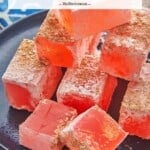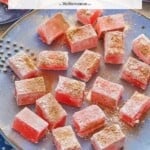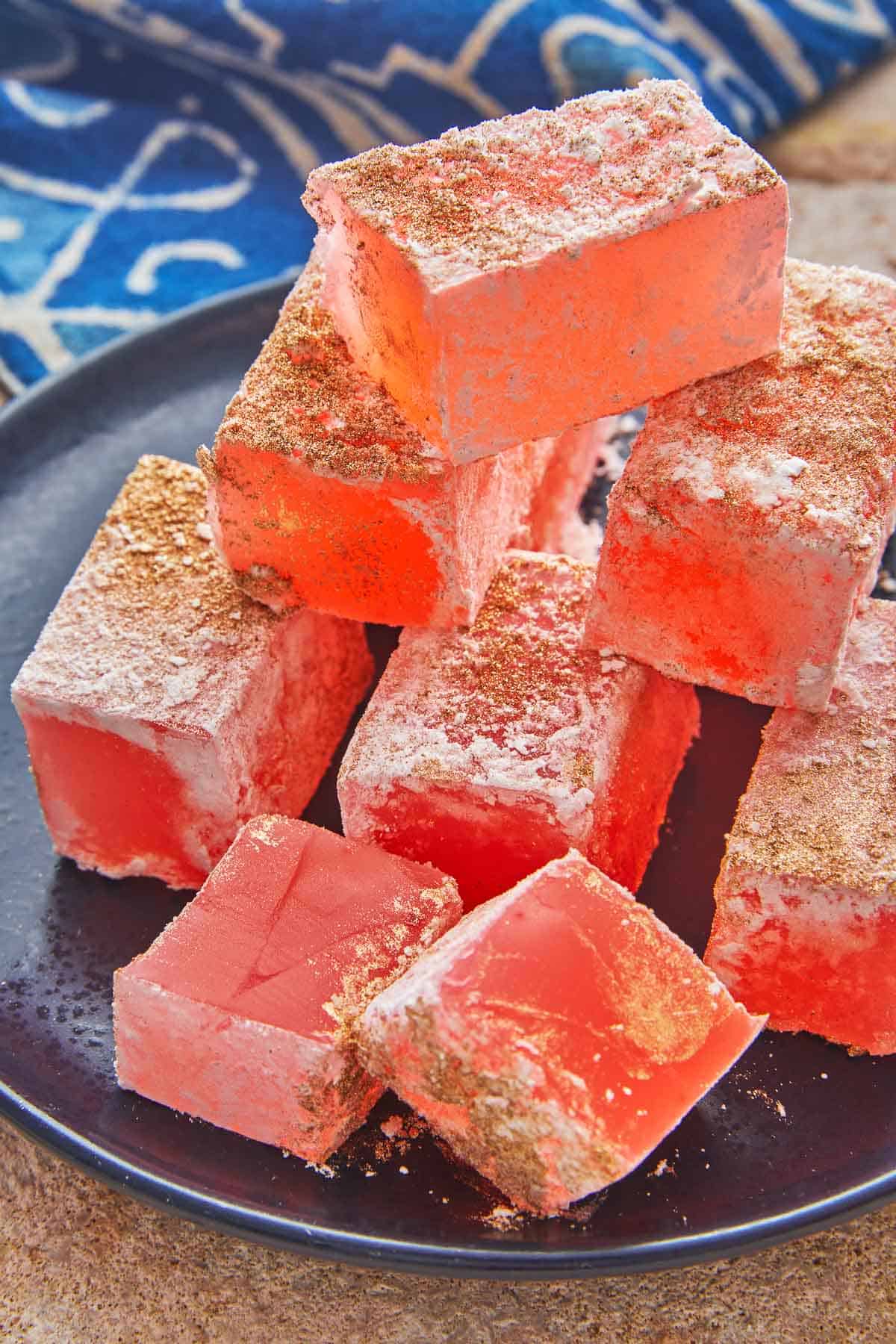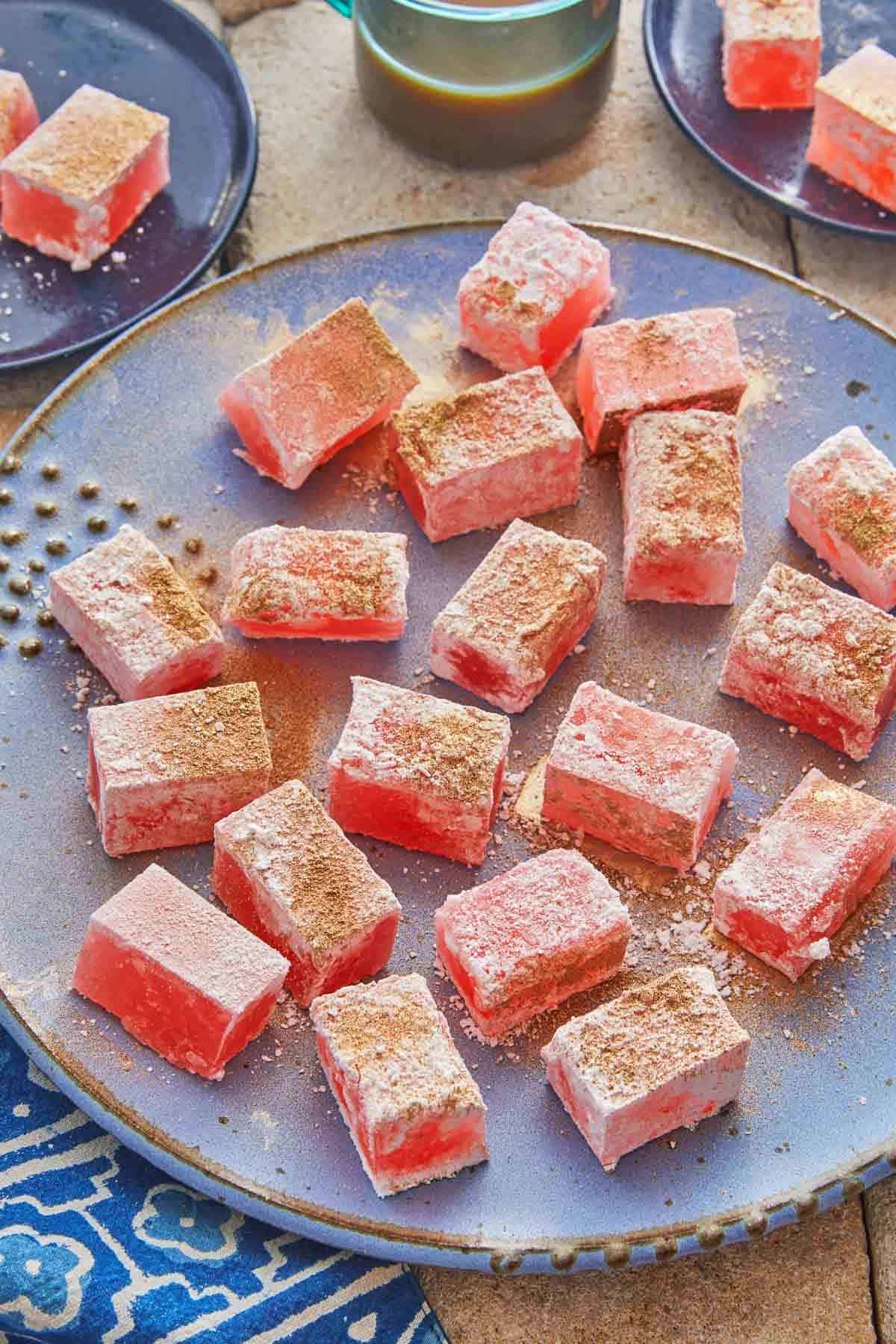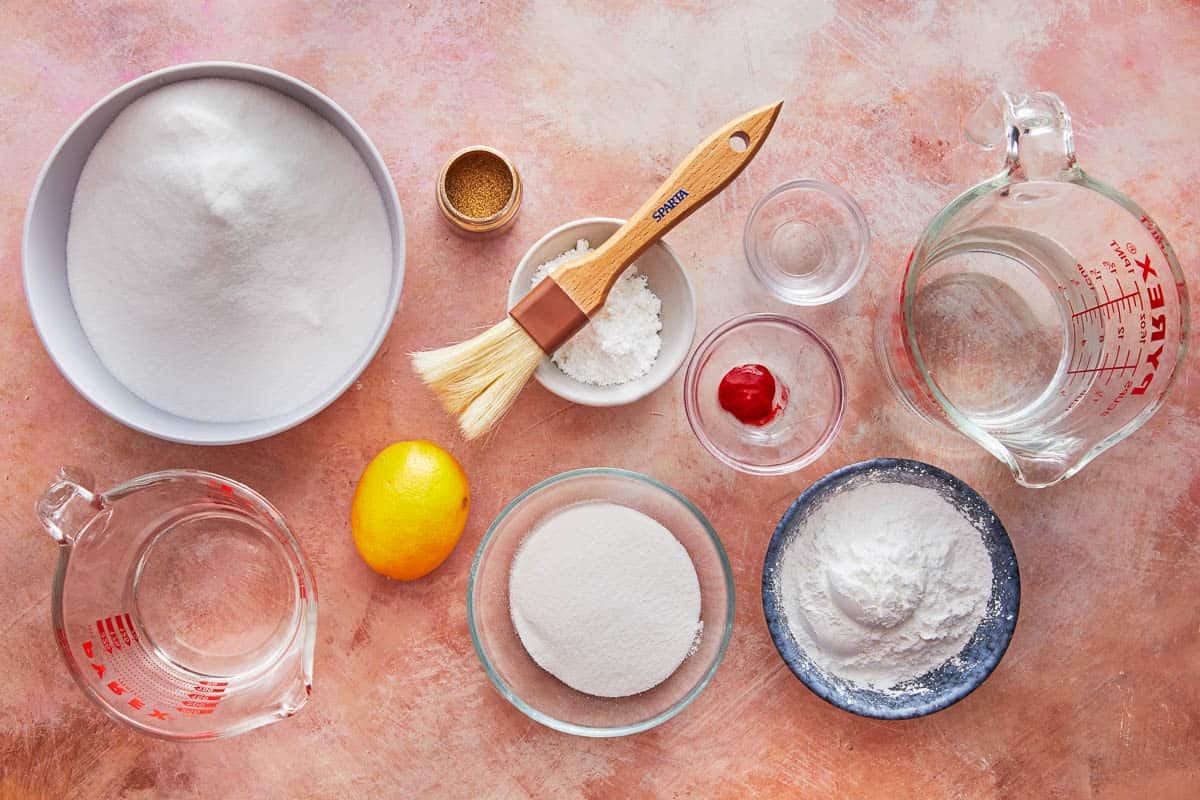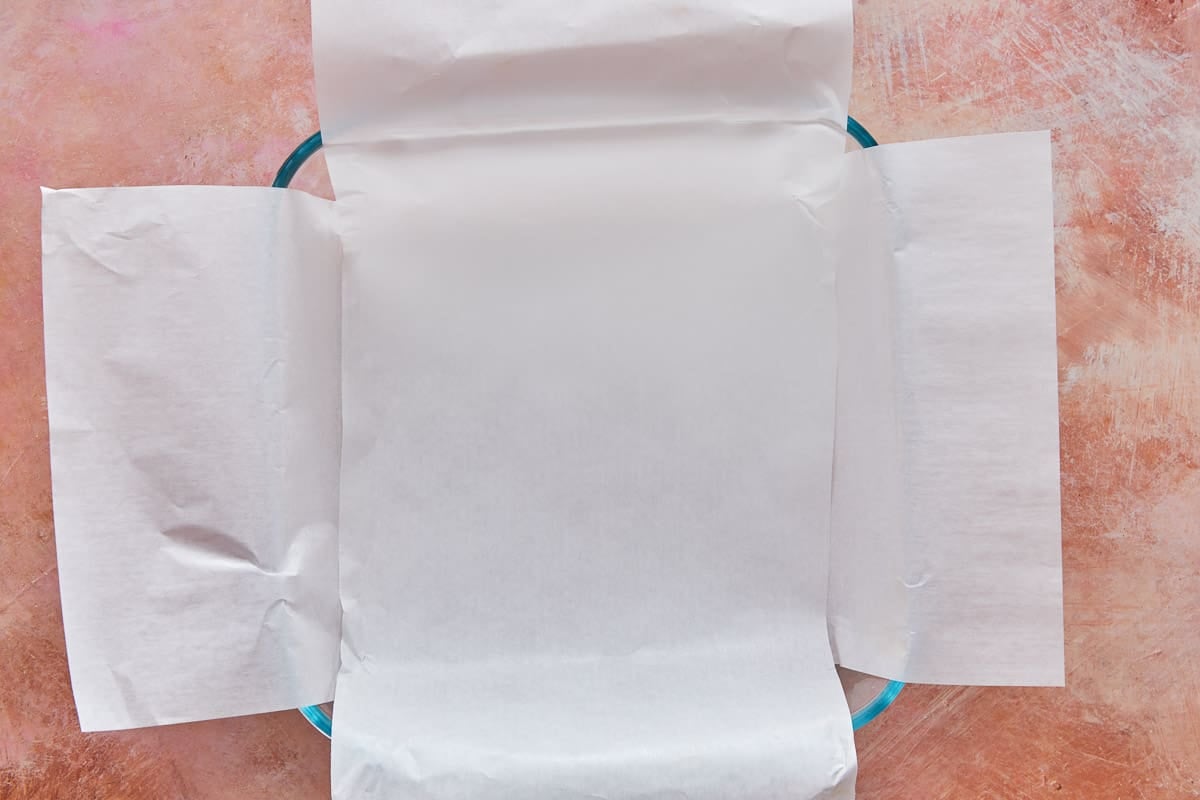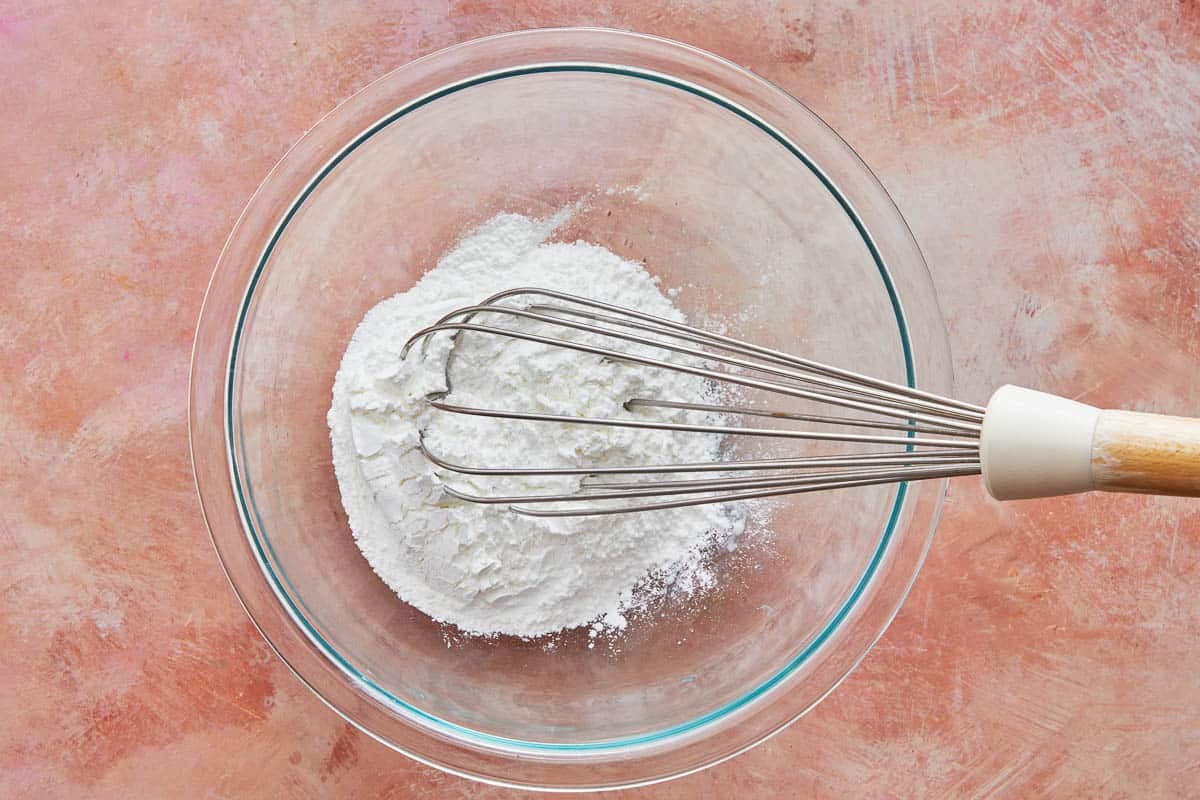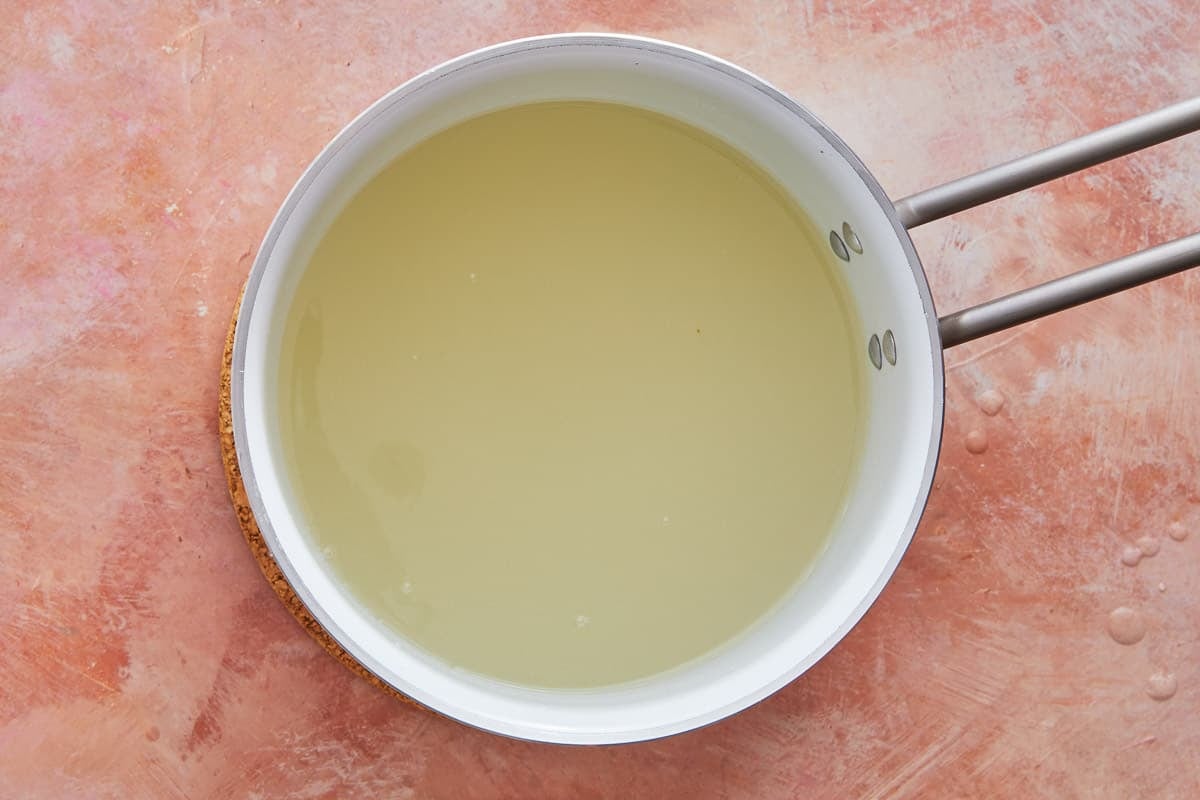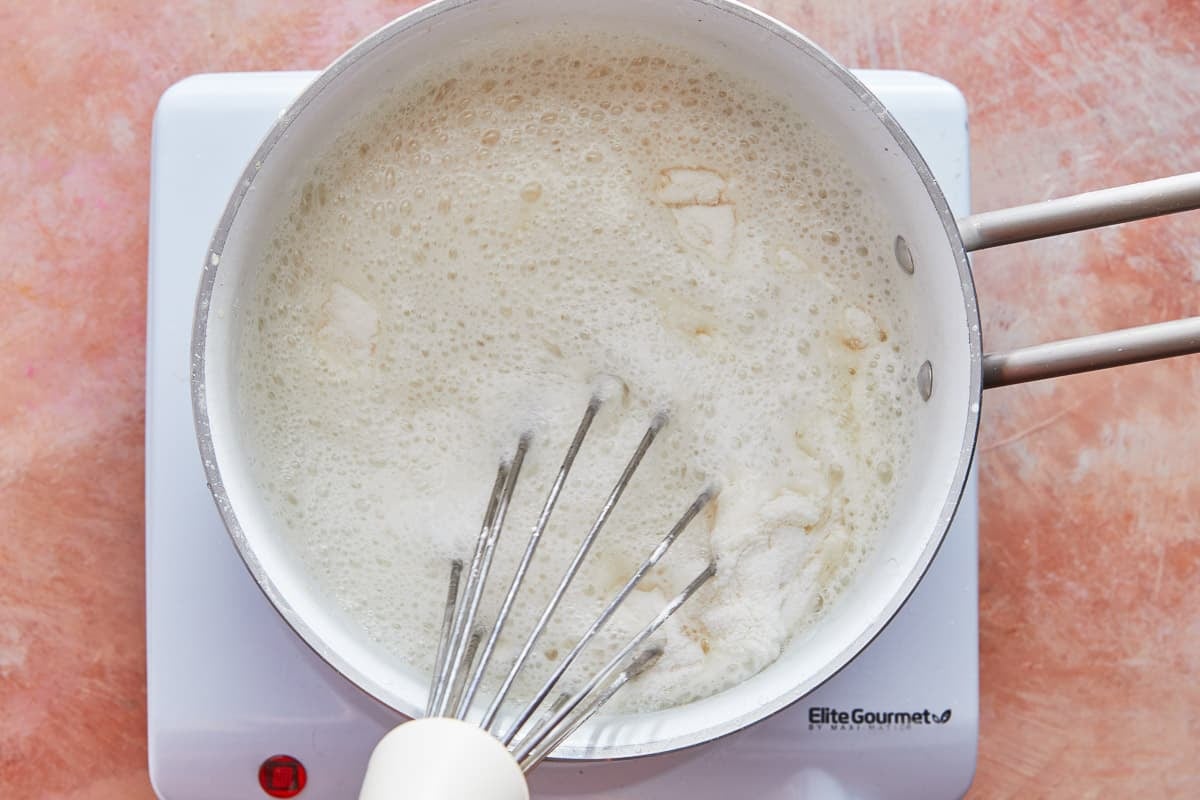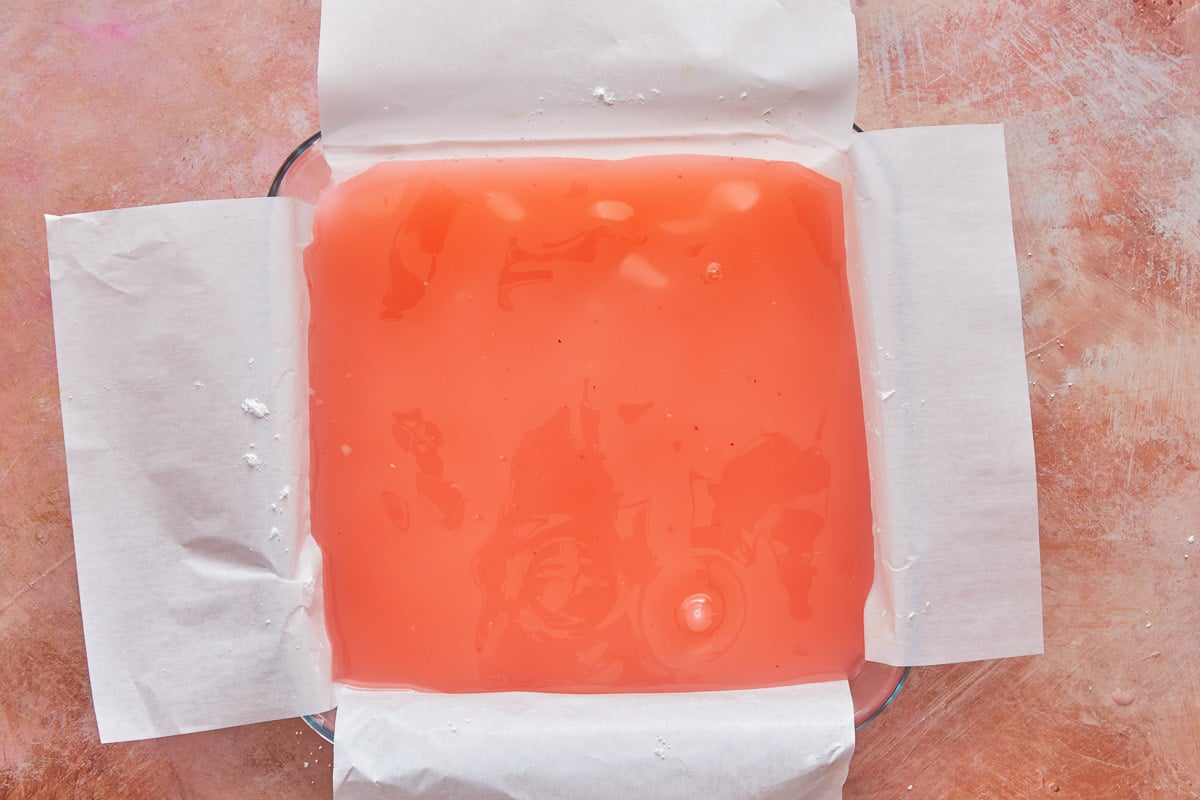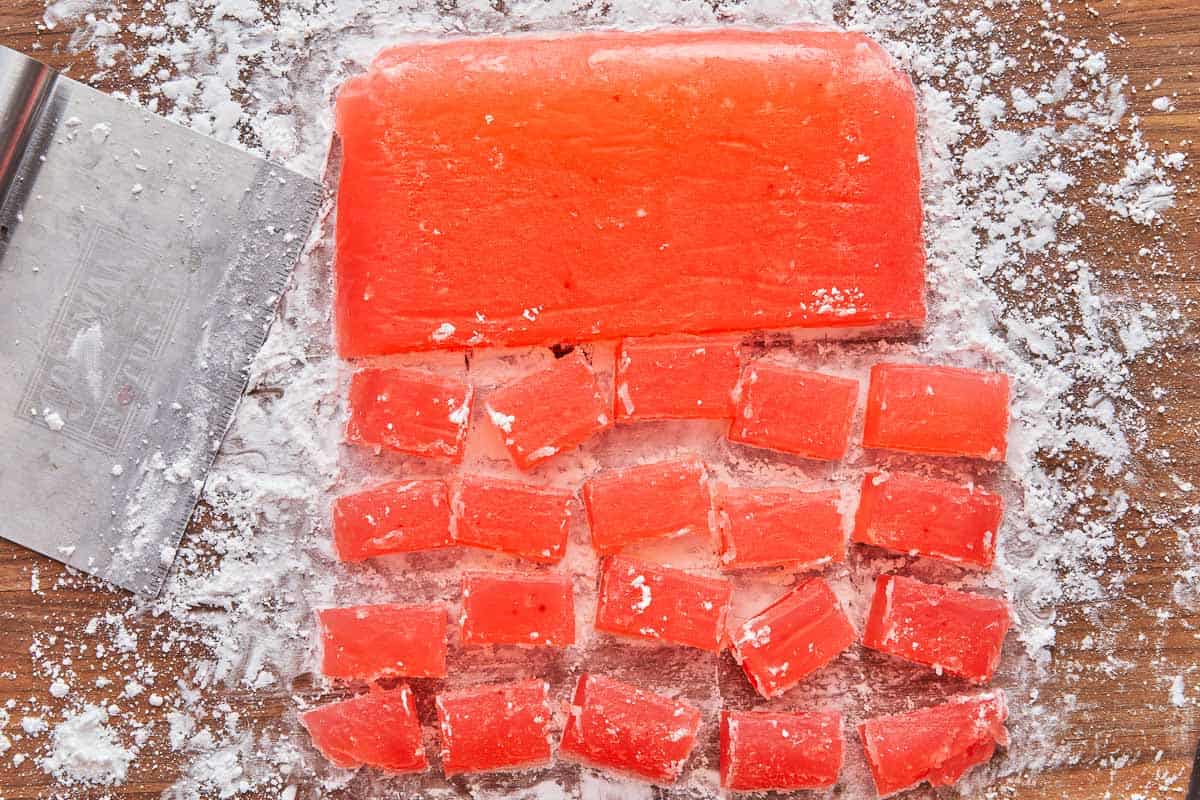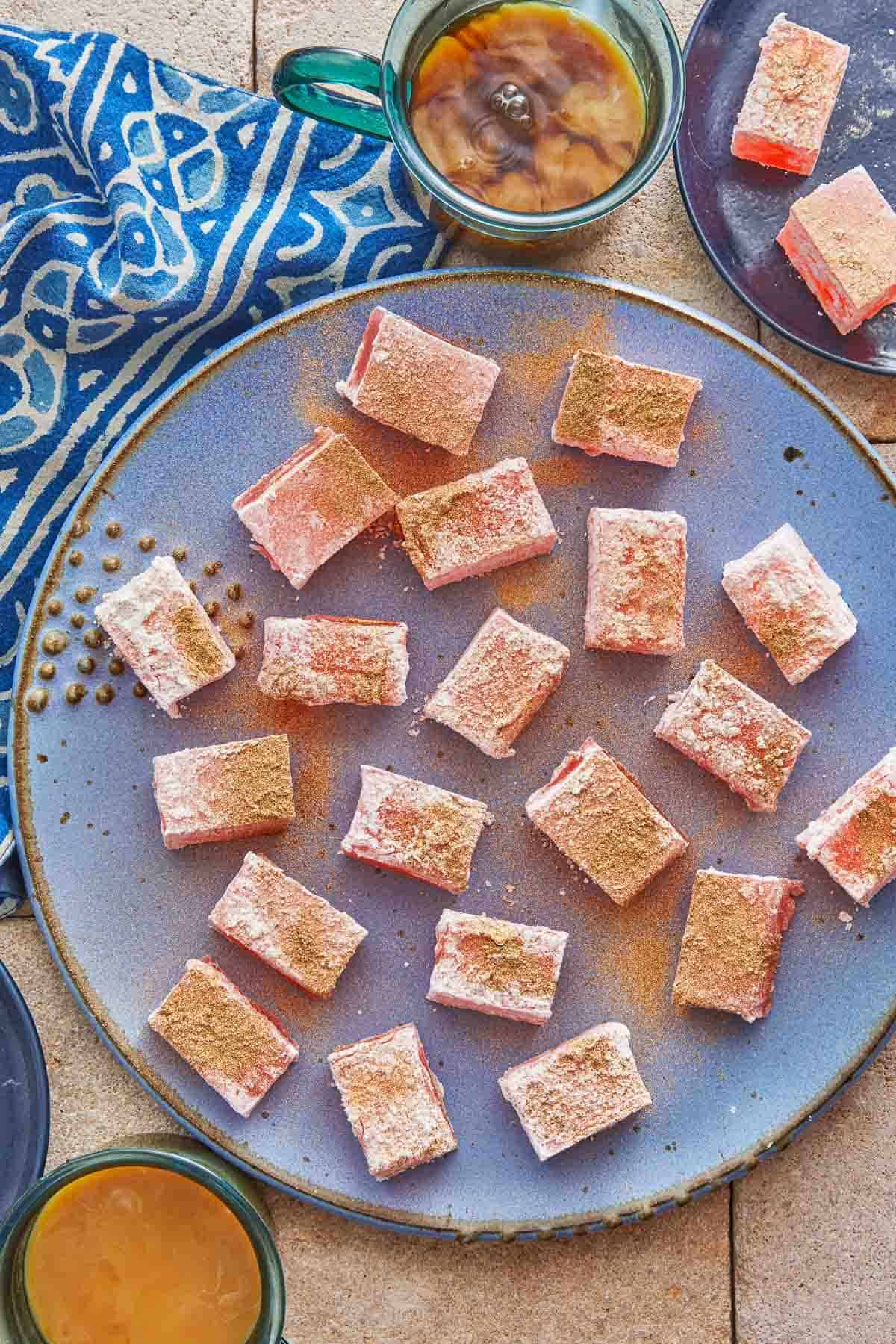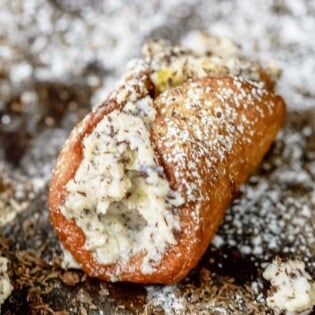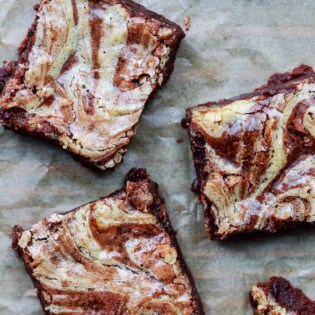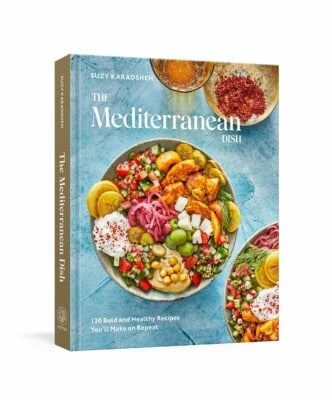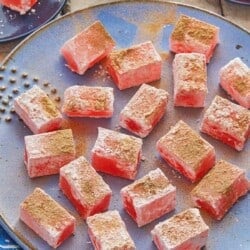Turkish Delight, also known as Lokum, is a delicately flavored, fragrant, chewy jelly candy that has been a hallmark of my homeland, Turkey, since Ottoman times. It’s one of my absolute favorite recipes and I’m happy to share it with you. The texture of Turkish delights is somewhere between a jelly candy and marshmallow. You can flavor it in any number of ways. In this recipe I use rosewater, which has a delicate floral note to it. You can find our favorite rosewater at our shop, or check the international aisle of your grocery store. If you’re new to rosewater, you can learn all about it, how to cook with it, our favorite type, and how it’s made in our “What Is Rose Water And How Do You Use It” essential guide. Start with a light hand — too much can taste soapy. If you don’t like rosewater go ahead and replace it with your favorite extract or dried fruit. Make this sweet, bite-sized candy and add it to your holiday dessert tray along with Egyptian Butter Cookies, Italian Biscotti, Candied Orange Peels, and Kuru Kayısı Tatlısı (Turkish Poached Apricots With Ricotta) for a celebration of international flavors. “Afiyet Olsun,” as we say in Turkish, which means “May you be happy and healthy with this food.” I hope you enjoy making this lokum recipe in your home as much as I do in mine.
What is Turkish Delight?
Turkish Delight or Turkish Delights also called Lokum are a fragrant jelly candy recipe native to Turkey. I make these delicate candies in a variety of ways including with rosewater, bergamot, cinnamon or orange and sometimes include coconut, dried fruits and nuts. Throughout Turkey they come in different colors, textures and flavor combinations. Throughout Turkey, these delicate candies are shared to close a meal with coffee, placed on dessert trays for holidays, weddings and other special occasions. Basically, people enjoy them whenever they can all year long!
History and Origins of Turkish Delight
Lokum is an important part of the Ottoman cuisine culture, adapted by many Middle Eastern and Balkan countries, with variations. The Turkish name Lokum is derived from the Arabic word luqma, meaning mouthful, morsel. Originally called “rahatu’l – hulkum,” rahat meaning ‘with ease,’ as the lokum comforted the throat and was easily swallowed. Eventually people called the candy “rahat lokum” and then simply “lokum.” The name wasn’t the only thing that changed. Originally, the Ottomans made a crude version of Turkish delight using honey or molasses. However, once refined sugar arrived in the late 18th century it slowly took over as the sweetening agent of choice. Haci Bekir, a well-known confectioner, became famous due to his ingenious use of white sugar and cornstarch. He was summoned to the Topkapi Palace to pioneer the development of what is today one of Turkey’s hallmark confections. Later on, rosewater and mastic, the resin of a tree used in many desserts from ice cream to commercially made Turkish delights, were also added to create more aromatic, chewier versions of the candy.
What is in Turkish Delight
Powdered sugar: This ingredient serves two purposes: to sweeten and to help prevent the cut pieces from sticking together. Cornstarch: This is mixed with the powdered sugar to absorb moisture to prevent sticking and added to the hot sugar mixture to help bind the candy. Superfine (Baker’s sugar): Superfine sugar is just smaller granules of granulated sugar, and if you can’t find it, it’s easy to make at home. Add granulated sugar to a food processor and pulse for about 30 seconds or so. Plain granulated sugar will also work; the candy will be a little less sweet. Lemon: The juice of the lemon is to add flavor and to help prevent the sugars from crystalizing. Gelatin: Acts as a binding agent. Without it the Turkish delight wouldn’t hold its shape. Rosewater: I love rosewater, but if you’re new to the flavor you might want to start with half the amount used in this recipe. Or you can use whatever your favorite extract is. Food coloring: This is optional and you can use it if you want a pink hue. You can skip it all together or use a little pomegranate juice to color it. Edible glitter: It’s just a little something special. You don’t need it.
How to Make Turkish Delight
Making a successful batch of Turkish delight depends upon the timing of a few ingredients and a candy thermometer. Prepare the baking dish: Turkish Delight is sticky. Lining your baking dish with parchment is essential for success. Make the dusting mixture: Combine the powdered sugar and cornstarch. A portion will be used to dust over the candy once it is set to prevent sticking. Make the sugar syrup: Combine the superfine sugar, lemon juice and 1 ¾ cups water into saucepan and set over medium low heat until the sugar is dissolved. Make the candy: In a small bowl, combine ½ cup plus 2 tablespoons cornstarch with ½ cup cold water. Whisk into hot sugar syrup. Sprinkle the gelatin over the sugar syrup and whisk to break up any lumps. Bring to a boil (you want the liquid to reach 250°F with a candy thermometer). Simmer over a medium heat for 20 minutes, whisking often. The mixture is ready when it thickens and turns pale yellow – like a soft jelly that is just about set. Flavor and set the candy: Remove from the heat and set aside for 5 minutes. Stir in the rose water and 1 to 2 drops of red food coloring. (If using chopped nuts, stir them in now.) Pour the mixture into the prepared dish. Leave it in a cool place on your countertop overnight. Ten to 12 hours is ideal, but if you’d like it to set even more you can leave it for up to 24 hours. Cut the Turkish delight: Dust a cutting board with some of the reserved dusting mixture and transfer the candy to the prepared cutting board. Use a sharp knife or a bench scraper to cut straight down through the candy. Do not drag the knife to cut into cubes. Once cut, coat each cube in the dusting mixture. Decorate with glitter: If using, go ahead and sprinkle the edible glitter over the Turkish delight. Dry: Line a baking sheet with parchment paper. Place the Turkish delight cubes in a single on the tray with a little space between each cube. Sprinkle the remaining cornstarch mixture over the candy and leave it uncovered on your countertop for 24 hours. The texture is somewhat between a homemade marshmallow and soft jelly.Enjoy and store: Turkish delight keeps well stored in a dry place for up to 1 month. Layer the candy between sheets of parchment in an airtight container on your countertop in a cool, dry place away from light and heat. Make sure there is a little space between each piece of Turkish delight.
Varieties of Turkish Delight
Rosewater is one of the most common flavors of Turkish delights but there are endless variations. Once you start making it at home there is little doubt you will come up with a few of your own. Today, many varieties of Turkish delight are available in Turkey, including:
mint orange lemon bergamot cinnamon orange blossom water
Nuts are also common. When using nuts you only need to add about 2 ounces or about a ½ cup of nuts. Make sure you chop them before adding to the candy.
pistachios walnuts hazelnuts almonds
Tips for Making Turkish Delights
Making candy is both an art and a science. Follow the tips below for a successful candy making experience every time.
Unless you’re an expert candy maker then a candy thermometer is helpful to get to the proper hard ball sugar stage (250°F) for setting this candy. If it hasn’t set, allow another 8 hours or if possible another day to set; as humidity, coolness of the room may impact drying time. . Homemade Turkish delight is softer than the commercially available ones, as there are no preservatives in them. Let the Turkish delight air dry for 24 hours after cutting it. This will prevent homemade Turkish delight from sweating.
How to Store Turkish Delights
Store Turkish delight in an airtight glass or metal container at room temperature a cupboard or pantry away from heat and sunlight is perfect. They will keep for up to 1 month. Do not store Turkish delight in the fridge, as the fridge would make it sweat, drawing more moisture out of the candy.
Perfect for Gift Giving
These sweet treats make lovely gifts during the holiday season. To pack Turkish delights as gifts, sprinkle a little cornstarch mixture into a paper bag to stop the sweets from sticking. Feel free to add some edible glitter for a festive touch. Seal up the bag and share with friends and family near and far.
More Sweet Treats
Browse all Mediterranean recipes.Visit Our Shop.
Cannoli Recipe (How to Make Cannoli Filling & Shells)
Melomakarona Greek Cookies
Tahini Brownies Recipe
Loukoumades
The Mediterranean Dish Cookbook: 120 Bold and Healthy Recipes You’ll Make on Repeat. In her book, Suzy brings cross-culturally inspired dishes from throughout the Mediterranean to you, using easy-to-find ingredients and easy-to-follow, to make your meals more vibrant, delicious, and yes — even a little healthier, too!
